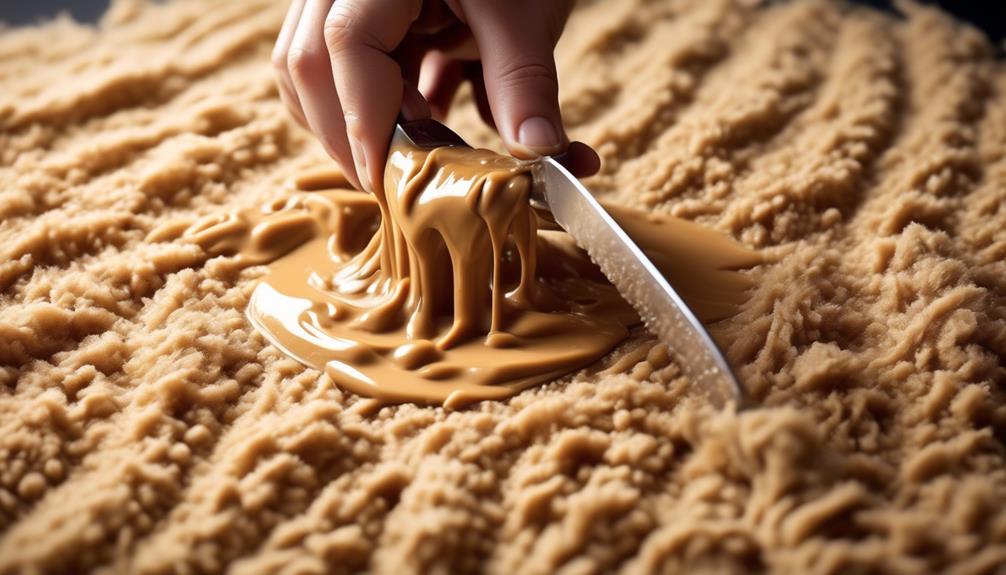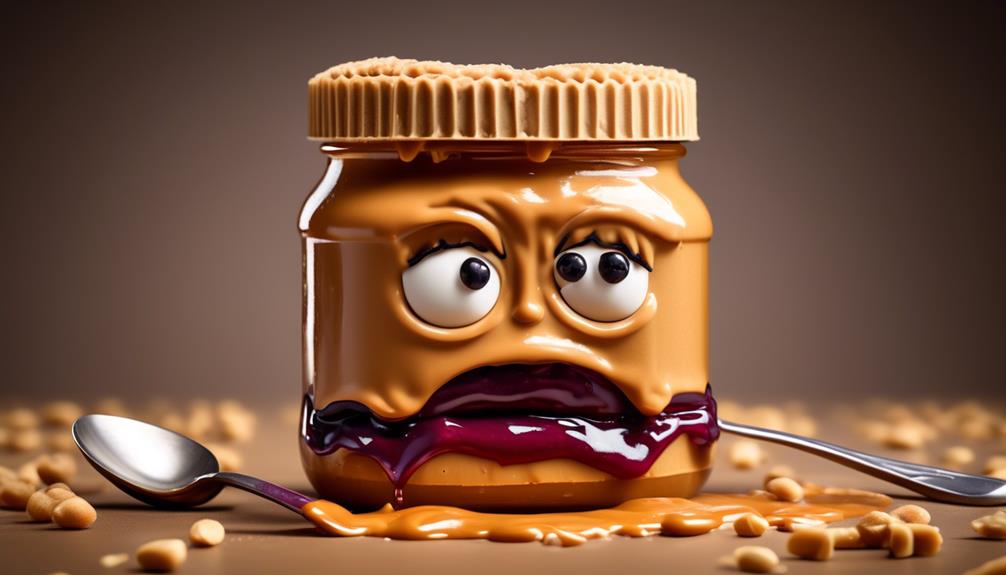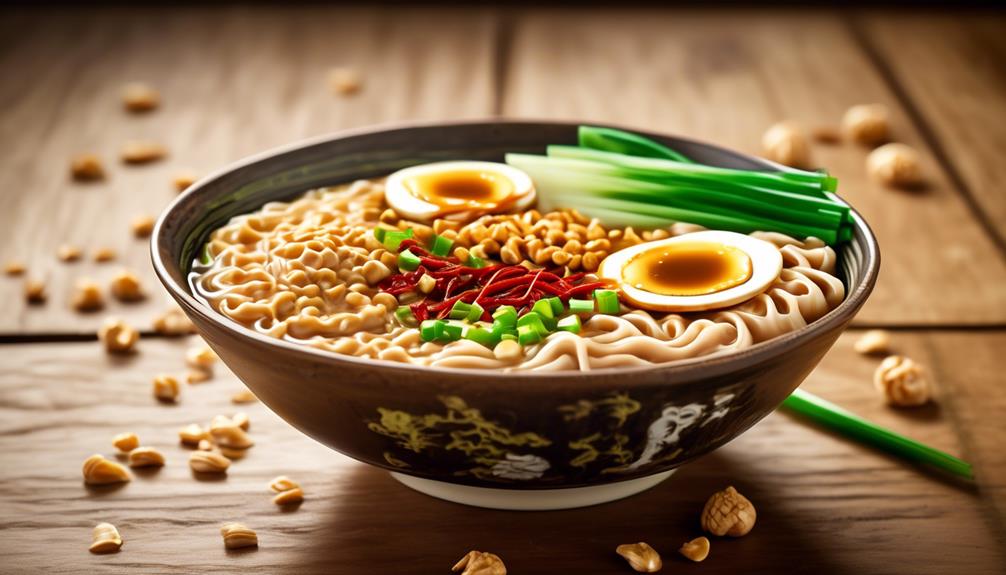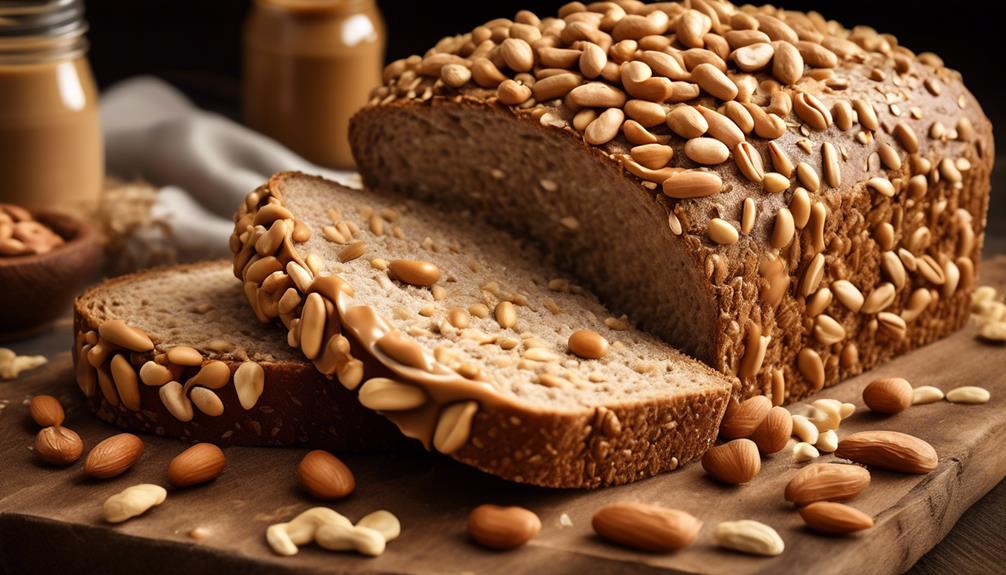We’ve all experienced it – a small accident with a snack that leaves a tough peanut butter stain on the carpet. Dealing with it can be a challenge, but don’t worry, there are effective methods to address this common problem.
You might be surprised to learn that the solution could be hiding in your kitchen pantry. But before we get into that, let's explore some simple yet essential steps to address this sticky situation.
Key Takeaways
- Identify the peanut butter stain by looking for dark, oily patches with a distinct odor and greasy texture.
- Remove excess peanut butter by gently scraping it off with a spoon or dull knife, then blot the area with a clean paper towel.
- Use household items like vinegar, baking soda, and a mixture of warm water, liquid dish soap, and vinegar to treat the stain.
- Rinse the treated area with warm water, blot dry, and allow the carpet to air dry completely before using the area again.
Identifying the Peanut Butter Stain
When identifying a peanut butter stain on the carpet, look for a dark, oily patch with a distinct peanut butter odor and a thick, greasy texture. Check for any remaining solid peanut butter residue and observe if the stain has spread due to previous cleaning attempts. It's essential to note any discoloration or dark spots on the carpet where the peanut butter was spilled.
To tackle this stubborn stain, start by gently scraping off any excess peanut butter with a spoon or dull knife. Be cautious not to push the peanut butter further into the carpet fibers.
Once the excess is removed, mix a small amount of dish soap with warm water and dab the stained area with a clean cloth. Blot, don't rub, to avoid spreading the stain.
For persistent stains, consider using a carpet stain remover, following the product's instructions carefully. Always test the cleaner on a small, inconspicuous area of the carpet first.
With patience and persistence, you can effectively remove the peanut butter stain from your carpet.
Removing Excess Peanut Butter From Carpet

When dealing with excess peanut butter on the carpet, it's important to avoid spreading the stain further.
We can start by using a dull knife or spoon to gently lift away the excess peanut butter.
It's crucial to blot the area rather than rubbing, as this can help prevent the stain from setting deeper into the carpet fibers.
Blotting With Paper Towels
Gently blot the affected area with a clean paper towel to remove excess peanut butter from the carpet. Be careful not to rub the peanut butter into the carpet, as this can push it further into the fibers. Use a fresh paper towel to soak up as much peanut butter as possible from the carpet. Continue blotting with fresh paper towels until no more peanut butter is being absorbed. Repeat the blotting process with fresh paper towels until the area is as dry as possible.
| Blotting Tips | Effectiveness | Outcome |
|---|---|---|
| Use gentle pressure | High | Prevents spreading |
| Change paper towels | High | Ensures thorough removal |
| Patience | High | Achieves better results |
Blotting with paper towels is crucial to effectively removing excess peanut butter from the carpet. It helps prevent the stain from setting and prepares the carpet for the next cleaning steps, such as using detergent or vinegar to tackle any remaining residue.
Using a Butter Knife
To remove excess peanut butter from the carpet, consider gently scraping it off with a butter knife to prevent spreading the stain further. When using a butter knife to remove peanut butter from the carpet, follow these steps:
- Scrape off excess peanut butter using the edge of a butter knife to lift as much of the substance as possible without pushing it deeper into the carpet fibers.
- Avoid using excessive force to prevent damaging the carpet fibers while scraping off the peanut butter.
- Once the excess peanut butter is removed, use a clean white cloth and blot dry to remove any remaining residue, helping to lift the stain from the carpet fibers.
This method allows for the effective removal of excess peanut butter, preventing further spread and making the overall carpet cleaning process more manageable.
Using Household Items to Treat the Stain

Alright, let's talk about using household items to tackle that peanut butter stain.
We can use vinegar to help lift the stain, while baking soda can absorb excess oil and residue.
Mixing some liquid dish soap with warm water also creates a gentle but effective cleaning solution.
Vinegar for Stain Removal
When dealing with a peanut butter stain on your carpet, a solution of warm water, liquid dishwashing detergent, and distilled white vinegar can effectively remove the stain. Here's how to use vinegar for stain removal:
- Create a solution of two cups warm water, one tablespoon liquid dishwashing detergent, and two tablespoons distilled white vinegar.
- Ensure the cloth or sponge is clean and white to avoid transferring any color onto the carpet.
- Blot the stain gently with the solution-soaked cloth, working from the outside edge toward the center.
- Rinse the cleaned area with a cloth dipped in plain water to remove any residue.
- Allow the area to air dry without direct heat and then vacuum to restore carpet fibers.
Using vinegar in this manner can help break down the peanut butter and effectively remove the stain from your carpet.
Baking Soda Absorbency
Using household items to treat a peanut butter stain on carpet, one can harness the absorbent power of baking soda to effectively lift the residue and oil from the fibers.
Sprinkle baking soda over the peanut butter stain to absorb excess oil and residue, then gently press it into the carpet.
Leave it for at least 15-20 minutes to allow the baking soda to work its magic.
Afterward, vacuum up the baking soda to remove the absorbed peanut butter and residue.
If the stain persists, repeat the process until the peanut butter stain is lifted from the carpet fibers.
Finally, finish by blotting the area with a clean cloth dampened with cold water to remove any remaining residue.
Baking soda's absorbency makes it an excellent solution for tackling tough peanut butter stains on carpet.
Dish Soap and Water
After harnessing the absorbent power of baking soda to lift the residue and oil from the carpet, the next step in treating the peanut butter stain involves using a mixture of warm water, liquid dishwashing detergent, and distilled white vinegar to create an effective cleaning solution.
- Apply a small amount of the cleaning solution onto a clean white cloth, paper towel, or sponge.
- Dip the cloth in the solution and wring out excess moisture.
- Blot the area, working from the outside edge toward the center, using the solution-soaked cloth.
Rinse the cleaned area with a cloth dipped in plain water and blot dry to remove the detergent/vinegar.
- Blot until the liquid is absorbed and the carpet is nearly dry.
- Allow the area to air dry without direct heat and then vacuum to restore carpet fibers.
Applying Stain Removal Techniques

To effectively apply stain removal techniques for removing peanut butter from carpet, begin by using a dull knife or spoon to lift away as much solid peanut butter as possible without spreading it further. It's essential to avoid wiping or rubbing the stain with a paper towel; instead, gently blot the stain to prevent it from setting deeper into the fibers.
When creating a cleaning solution, mix warm water with liquid dishwashing detergent and distilled white vinegar to treat the stained area. Gently work from the outside edge toward the center of the stain using the solution-soaked cloth to prevent spreading the peanut butter further.
Rinse the cleaned area with plain water and allow it to air dry without direct heat, then vacuum to restore the carpet fibers.
If the stain persists, consider using acetone or a specialized carpet cleaner, following the manufacturer's instructions carefully.
Rinsing and Drying the Carpet

We have successfully applied the cleaning solution and treated the stained area, now it's essential to thoroughly rinse the carpet with plain water to remove any soap residue before proceeding to dry it. Here's how to effectively rinse and dry the carpet:
- Rinse with Warm Water: After applying the cleaning solution, use a clean cloth dipped in warm water to thoroughly rinse the treated area. This helps to remove any remaining soap residue and peanut butter remnants.
- Blot the Area: Once the carpet has been rinsed, gently blot the area with a clean cloth to absorb excess moisture. This aids in the drying process and prevents water from seeping deeper into the carpet fibers.
- Air Dry Completely: Allow the carpet to air dry completely before using the area. This step is crucial in preventing any further staining or damage. If available, using a wet/dry vacuum can speed up the drying process and ensure the carpet is thoroughly dry.
Final Tips for Stain-Free Carpets

For optimal maintenance of stain-free carpets, it is advisable to act promptly and use appropriate cleaning techniques to prevent peanut butter stains from setting deeply into the carpet fibers. To ensure your carpets remain free from stains, follow these final tips:
| Tip | Description |
|---|---|
| Act Quickly | Remove excess peanut butter using a dull knife or spoon to prevent further spreading and deeper stain setting. |
| Gentle Cleaning Solution | Use a solution of warm water, liquid dishwashing detergent, and distilled white vinegar to gently clean the stain, working from the outside edge toward the center. |
| Avoid Pushing Deeper into Fibers | Avoid using paper towels to wipe or rub the stain as it can push the peanut butter deeper into the carpet fibers. |
| Rinse and Restore | Rinse the cleaned area with a cloth dipped in plain water to remove any cleaning solution residue and prevent attracting soil. Allow the carpet to air dry without direct heat and then vacuum to restore the carpet fibers. |
Following these tips will help you maintain a clean and stain-free carpet. Remember, always blot the stain rather than scrubbing and test any cleaning solution, such as acetone, on a small, inconspicuous area of the carpet first to ensure it doesn't cause damage.
Frequently Asked Questions
Do Peanut Butter Stains Come Out?
Peanut butter stains can definitely come out of carpet and upholstery with the right cleaning techniques. It's important to act quickly and avoid rubbing the stain further into the fibers.
Using warm water, dishwashing detergent, and vinegar can effectively lift the stain. Properly rinsing and blotting the cleaned area is crucial to prevent any residue and fully remove the stain.
Seek professional help for delicate upholstery like silk or vintage pieces.
How Do You Get Butter Out of Carpet?
Sure, we've dealt with similar stains before.
To remove butter from carpet, start by scraping off excess butter with a spoon.
Blot the area with a cloth soaked in warm water and a little dish soap.
Then, use a mixture of water and vinegar to further clean the spot.
Finally, blot with a clean cloth until the area is dry.
This method should help to lift the butter out of the carpet fibers.
How Do You Get Peanut Butter Out of a Wool Rug?
We always use a gentle approach to remove peanut butter from a wool rug. First, we lift away excess peanut butter with a dull knife or spoon.
Then, we make a cleaning solution of warm water, liquid dishwashing detergent, and distilled white vinegar.
We gently work on the stain, blotting from the outside edge toward the center to avoid spreading.
After rinsing and air-drying, we vacuum the area to restore the rug's appearance.
How Do You Get Peanut Oil Out of Carpet?
We remove peanut oil from carpet by lifting away excess oil with a dull knife. Then, we avoid wiping or rubbing.
Next, we mix warm water, liquid dishwashing detergent, and vinegar to make a cleaning solution.
Using a clean cloth or sponge, we gently work from the outside edge toward the center of the stain.
This method effectively removes peanut oil from carpet, preserving its quality.
Conclusion
In the end, getting peanut butter out of carpet is a piece of cake!
With a little bit of patience and the right tools, you can easily tackle those stubborn stains.
So next time you find yourself in a sticky situation, remember these tips and you'll have your carpet looking good as new in no time!










